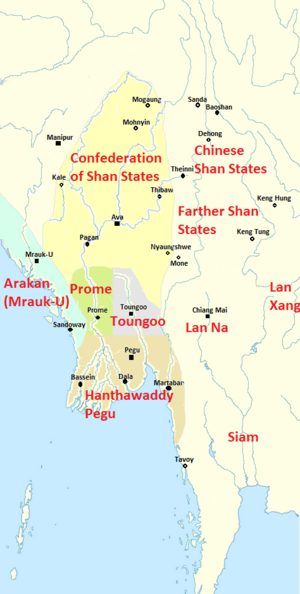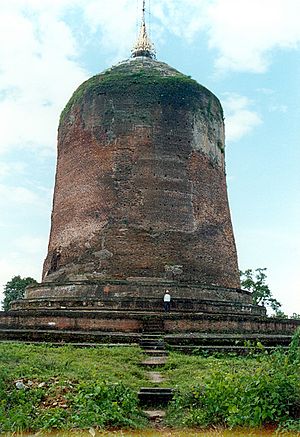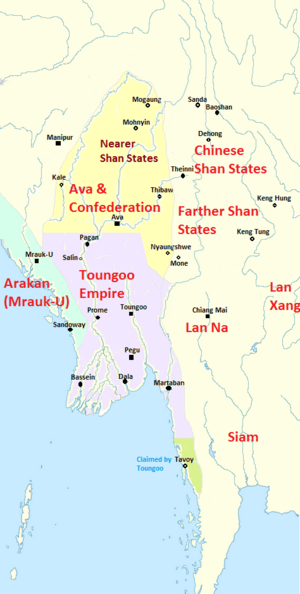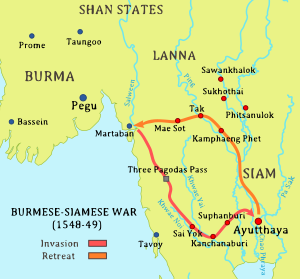Tabinshwehti facts for kids
Quick facts for kids Tabinshwehtiတပင်ရွှေထီး |
|
|---|---|

Tabinshwehti Nat
|
|
| King of Burma | |
| Reign | 24 November 1530 – 30 April 1550 |
| Coronation | 24 November 1530 |
| Predecessor | Mingyi Nyo |
| Successor | Bayinnaung |
| Born | 16 April 1516 Wednesday, 1st waning of Kason 878 ME Toungoo (Taungoo) |
| Died | 30 April 1550 (aged 34) Wednesday, 1st waning of Kason 912 ME near Pantanaw |
| Burial | near Pantanaw |
| Spouse | Dhamma Dewi Khin Myat Khay Ma Naw |
| Issue | Min Letya Hanthawaddy Mibaya |
| House | Toungoo |
| Father | Mingyi Nyo |
| Mother | Yaza Dewi |
| Religion | Theravada Buddhism |
Tabinshwehti (Burmese: တပင်ရွှေထီး; 16 April 1516 – 30 April 1550) was a powerful king of Burma (now Myanmar). He ruled from 1530 to 1550. He is known as the founder of the First Toungoo Empire, which was a very large kingdom.
His military actions between 1534 and 1549 created the biggest kingdom in Burma since the Pagan Empire fell in 1287. Even though his kingdom was not very organized, it helped his successor, Bayinnaung, to unite the whole country later.
Tabinshwehti and his trusted friend, Bayinnaung, started their military campaigns in 1534. They attacked the Hanthawaddy Kingdom, which was richer but not united. By 1541, they had conquered it. Tabinshwehti then used the wealth and people from this coastal kingdom. He also got help from Portuguese soldiers and their guns.
He expanded his rule to the old capital of Pagan (Bagan) by 1544. However, his efforts to create a huge empire in the East and West did not fully succeed. He faced challenges in Arakan (1545–1547) and Siam (1547–1549).
He worked hard to get the support of the Mon people from Lower Burma. Many Mons were given important jobs in his government and army. His main queen and chief religious leader were also Mons. He moved his capital to Pegu (Bago).
Sadly, the king was killed on his 34th birthday by one of his close advisors, Smim Sawhtut. The kingdom he had built fell apart right after his death. Bayinnaung had to work for two years to bring it back together.
Historians say his early death was a "turning point" in Southeast Asian history. He is still one of the most famous kings in Burmese history. The Tabinshwehti nat is one of the 37 nats (spirits) that people worship in Myanmar.
Contents
Early Life of Tabinshwehti
Birth and Childhood
Tabinshwehti was born at Toungoo Palace on April 16, 1516. His father was King Mingyi Nyo of Toungoo, and his mother was Khin Oo. His father, who was 56 years old, really wanted a son. So, he named the baby boy Tabinshwehti, which means "Unitary Golden Umbrella." The golden umbrella was a symbol of Burmese kings.
The king also made the boy's mother a queen. Tabinshwehti was a descendant of King Minkhaung I of Ava. His mother, Khin Oo, was from a common family.
| Family tree of King Tabinshwehti | |||||||||||||||||||||||||||||||||||||||||||||||||||||||||||||||||||||||||||||||||||||||||||||||||||||||||||||||||||||||||||||||||||||||||||||||||||||||||||||||||||||||||||||||||||||||||||||||||||||||||||||||||||||||||||||||||||||||||||||||||||||||||||||||||||||||||||||||||||||||||||||||||||||||||||||||||||||||||||||||||||||||||||||||||||||||||||||||||||||||||||||||||||||||||||||||||||||||||||||||||||||||||||||||||||||||||||||||||||||||||||||||||||||||||||||||||||||||||||||||||||||||||||||||||||||||||||||||||||||||||||||||||||||||||||||||||||||||||||||||||||||||||||||||||||||||||||||||||||||||||||||||||||||||||||||||||||||||||||||||||||||||||||||||||||||||||||||||||||||||||||||||||||||||||||||||||||||||||||||||||||||||||||||||||||||||||||||||||||||||||||||||||||||||||||||||||||||||||||||||||||||||||||||||||||||||||||||||||||||||||||||||||||||||||||||||||||||||||||||||||||||||||||||||||||||||||||||||||||||||||||||||||||||||||||||||||||
|---|---|---|---|---|---|---|---|---|---|---|---|---|---|---|---|---|---|---|---|---|---|---|---|---|---|---|---|---|---|---|---|---|---|---|---|---|---|---|---|---|---|---|---|---|---|---|---|---|---|---|---|---|---|---|---|---|---|---|---|---|---|---|---|---|---|---|---|---|---|---|---|---|---|---|---|---|---|---|---|---|---|---|---|---|---|---|---|---|---|---|---|---|---|---|---|---|---|---|---|---|---|---|---|---|---|---|---|---|---|---|---|---|---|---|---|---|---|---|---|---|---|---|---|---|---|---|---|---|---|---|---|---|---|---|---|---|---|---|---|---|---|---|---|---|---|---|---|---|---|---|---|---|---|---|---|---|---|---|---|---|---|---|---|---|---|---|---|---|---|---|---|---|---|---|---|---|---|---|---|---|---|---|---|---|---|---|---|---|---|---|---|---|---|---|---|---|---|---|---|---|---|---|---|---|---|---|---|---|---|---|---|---|---|---|---|---|---|---|---|---|---|---|---|---|---|---|---|---|---|---|---|---|---|---|---|---|---|---|---|---|---|---|---|---|---|---|---|---|---|---|---|---|---|---|---|---|---|---|---|---|---|---|---|---|---|---|---|---|---|---|---|---|---|---|---|---|---|---|---|---|---|---|---|---|---|---|---|---|---|---|---|---|---|---|---|---|---|---|---|---|---|---|---|---|---|---|---|---|---|---|---|---|---|---|---|---|---|---|---|---|---|---|---|---|---|---|---|---|---|---|---|---|---|---|---|---|---|---|---|---|---|---|---|---|---|---|---|---|---|---|---|---|---|---|---|---|---|---|---|---|---|---|---|---|---|---|---|---|---|---|---|---|---|---|---|---|---|---|---|---|---|---|---|---|---|---|---|---|---|---|---|---|---|---|---|---|---|---|---|---|---|---|---|---|---|---|---|---|---|---|---|---|---|---|---|---|---|---|---|---|---|---|---|---|---|---|---|---|---|---|---|---|---|---|---|---|---|---|---|---|---|---|---|---|---|---|---|---|---|---|---|---|---|---|---|---|---|---|---|---|---|---|---|---|---|---|---|---|---|---|---|---|---|---|---|---|---|---|---|---|---|---|---|---|---|---|---|---|---|---|---|---|---|---|---|---|---|---|---|---|---|---|---|---|---|---|---|---|---|---|---|---|---|---|---|---|---|---|---|---|---|---|---|---|---|---|---|---|---|---|---|---|---|---|---|---|---|---|---|---|---|---|---|---|---|---|---|---|---|---|---|---|---|---|---|---|---|---|---|---|---|---|---|---|---|---|---|---|---|---|---|---|---|---|---|---|---|---|---|---|---|---|---|---|---|---|---|---|---|---|---|---|---|---|---|---|---|---|---|---|---|---|---|---|---|---|---|---|---|---|---|---|---|---|---|---|---|---|---|---|---|---|---|---|---|---|---|---|---|---|---|---|---|---|---|---|---|---|---|---|---|---|---|---|---|---|---|---|---|---|---|---|---|---|---|---|---|---|---|---|---|---|---|---|---|---|---|---|---|---|---|---|---|---|---|---|---|---|---|---|---|---|---|---|---|---|---|---|---|---|---|---|---|---|---|---|---|---|---|---|---|---|---|---|---|---|---|---|---|---|---|---|---|---|---|---|---|---|---|---|---|---|---|---|---|---|---|---|---|---|---|---|---|---|---|---|---|---|---|---|---|---|---|---|---|---|---|---|---|---|---|---|---|---|---|---|---|---|---|---|---|---|---|---|---|---|---|---|---|---|---|---|---|---|---|---|---|---|---|---|---|---|---|---|---|---|---|---|---|---|---|---|---|---|---|---|---|---|---|---|---|---|---|---|---|---|---|---|---|---|---|---|---|---|---|---|---|---|---|---|---|---|---|---|---|---|---|---|---|---|---|---|---|---|---|---|---|---|---|---|---|---|---|---|---|---|---|---|---|---|---|---|---|---|---|---|---|---|---|---|---|---|---|---|---|---|---|---|---|---|---|---|---|---|---|---|---|---|---|---|---|---|---|---|---|---|---|---|---|---|---|---|---|---|---|---|---|---|---|---|---|---|---|---|---|---|---|---|---|---|---|---|---|---|---|---|---|---|---|---|---|---|---|---|---|---|---|---|---|---|---|---|---|---|---|---|---|---|---|---|---|---|---|---|---|---|---|
|
|||||||||||||||||||||||||||||||||||||||||||||||||||||||||||||||||||||||||||||||||||||||||||||||||||||||||||||||||||||||||||||||||||||||||||||||||||||||||||||||||||||||||||||||||||||||||||||||||||||||||||||||||||||||||||||||||||||||||||||||||||||||||||||||||||||||||||||||||||||||||||||||||||||||||||||||||||||||||||||||||||||||||||||||||||||||||||||||||||||||||||||||||||||||||||||||||||||||||||||||||||||||||||||||||||||||||||||||||||||||||||||||||||||||||||||||||||||||||||||||||||||||||||||||||||||||||||||||||||||||||||||||||||||||||||||||||||||||||||||||||||||||||||||||||||||||||||||||||||||||||||||||||||||||||||||||||||||||||||||||||||||||||||||||||||||||||||||||||||||||||||||||||||||||||||||||||||||||||||||||||||||||||||||||||||||||||||||||||||||||||||||||||||||||||||||||||||||||||||||||||||||||||||||||||||||||||||||||||||||||||||||||||||||||||||||||||||||||||||||||||||||||||||||||||||||||||||||||||||||||||||||||||||||||||||||||||||
The young prince was looked after by seven royal servants. He grew up playing with their children. One of these children was Ye Htut, who was three months older. Ye Htut would later become Tabinshwehti's most trusted helper.
Prophecy and Training
There was a prophecy that Tabinshwehti would become a great warrior, just like a famous prince named Minye Kyawswa. This prophecy was popular because Upper Burma was in a lot of trouble. Many small kingdoms were fighting each other.
Tabinshwehti's father, King Mingyi Nyo, had broken away from the larger Ava Kingdom in 1510. He wanted his son to be a strong leader. So, Tabinshwehti, along with Ye Htut and other young men, learned many military skills. They trained in martial arts, horseback riding, elephant riding, and war strategies.
Local stories say that when Tabinshwehti was born, the swords in the palace armory shone brightly. People believed this was a sign that he would be a powerful warrior.
First Experience with War
Tabinshwehti first saw warfare in 1525. Forces from Ava tried to attack Toungoo, but they failed. In the years that followed, many people from Upper Burma came to Toungoo. They were looking for a safe place because Ava was falling apart. This made Toungoo stronger with more people.
Early Reign and Decisions
Becoming King
Mingyi Nyo, Tabinshwehti's father, died on November 24, 1530. The 14-year-old prince immediately became king. He rewarded all the people who had helped him since childhood. He gave them royal titles. He also married two of their daughters, Khin Hpone Soe and Khin Myat. He made his young friends, including Ye Htut, his close advisors.
A Key Decision: Ye Htut's Loyalty
Around April 1534, a big problem arose. It was discovered that Tabinshwehti's half-sister, Thakin Gyi, was in love with Ye Htut. Under Burmese law, this was a serious crime. Ye Htut could have tried to start a rebellion, but he chose to surrender.
Tabinshwehti thought about it for a long time with his ministers. Finally, he decided to let Ye Htut marry his sister. He also gave Ye Htut a princely title, Kyawhtin Nawrahta. This decision made Ye Htut extremely loyal to Tabinshwehti.
Choosing to Fight
By late 1532, war was getting very close to Toungoo. The Confederation of Shan States, which controlled much of Upper Burma, attacked Prome. Toungoo leaders worried that their city, which was close to Prome, would be next.
Toungoo had some advantages. It was hidden behind mountains, making it hard to attack. Also, with all the refugees, Toungoo now had more people than before. Still, the leaders decided they "had to act quickly" to avoid being taken over.
In late 1534, Tabinshwehti made a bold decision. He decided to attack the Hanthawaddy Kingdom to the south. This was a big change from his father's peaceful policy. The 18-year-old king was likely convinced by older, experienced ministers. Over the next 16 years, Tabinshwehti and Ye Htut (who became Bayinnaung) would unite many small kingdoms.
Building the Toungoo Empire
Conquering Lower Burma (1534–1541)
The king and his court chose Hanthawaddy as their first target. Hanthawaddy seemed strong on paper, but its ruler, King Takayutpi, was not very experienced. His local leaders in Martaban and the Irrawaddy delta were not loyal to him. Hanthawaddy was also rich from trade, which made it an attractive target.
Toungoo leaders believed Takayutpi would not fight back strongly. Earlier, Tabinshwehti and his men had even visited the Shwemawdaw Pagoda near Pegu, Hanthawaddy's capital, without permission. Takayutpi did nothing. Unlike his strong father, Takayutpi could not organize his kingdom's resources to fight back.
Taking Pegu and the Delta (1534–1539)
At first, Toungoo's attacks were just small raids. Their raids in 1534–1535, 1535–1536, and 1536–1537 all failed. Pegu had strong defenses, helped by foreign soldiers and guns. Toungoo's armies were small, with only 6,000 to 7,000 men. They did not yet have foreign soldiers or firearms. As expected, Takayutpi did not attack Toungoo in return. His local leaders did not send him any help.
After many failures, Toungoo used a trick. They spread false information to make Takayutpi doubt his own ministers. Surprisingly, Takayutpi believed the lies. He executed his two main ministers, who had been loyal to him since childhood.
When Toungoo attacked again, Takayutpi was helpless. He decided to leave his capital instead of fighting. Toungoo forces took Pegu without a fight in late 1538 or early 1539. Hanthawaddy's hope for a counterattack ended after the Battle of Naungyo. In this battle, General Kyawhtin Nawrahta's Toungoo troops won a great victory.
Tabinshwehti then gave Kyawhtin Nawrahta the new title of Bayinnaung ("King's Elder Brother"). Toungoo forces followed Takayutpi to Prome, but the Confederation of Shan States helped Prome. Takayutpi died soon after, around March 1539. Many local leaders from the delta then joined Tabinshwehti. He let them keep their positions. Now, Tabinshwehti controlled much of Lower Burma's people and trade wealth. He also gained access to Portuguese soldiers and their powerful guns.
Conquering Martaban (1540–1541)
Tabinshwehti wanted to control all of Lower Burma. In 1540, he told Martaban, the last area not under his control, to surrender. He offered them forgiveness. However, the rich city's ruler, Saw Binnya, refused. He had made his city very strong and hired Portuguese soldiers and sailors.
In November 1540, 13,000 Toungoo soldiers and sailors attacked Martaban. For seven months, Martaban's Portuguese-led defenses held them off. Finally, in May 1541, Admiral Smim Payu's fleet broke through the Portuguese warships guarding the harbor. The city fell.
The city was looted for three days. Tabinshwehti ordered the execution of the ruler, his family, and all the brave defenders. They had refused his offer of peace. This harsh action had the desired effect. The governors of Moulmein and other southern areas, near the Siamese border, surrendered. He appointed Saw Lagun Ein, Takayutpi's brother-in-law, as the new ruler of Martaban.
Expanding to Prome and Upper Burma (1541–1545)
Controlling Martaban gave Tabinshwehti full control of Lower Burma's people. It also gave him access to foreign guns and money to pay for them. He used these new resources to expand his kingdom further.
The sudden rise of Toungoo caught the attention of other kingdoms. Both the Confederation of Shan States and the Arakan kingdom promised military help to Prome. Prome was important because it was the gateway to Upper Burma.
Throughout the rainy season of 1541, Tabinshwehti gathered a huge army and navy. His 13 naval squadrons had 9,000 troops and many war boats. They were led by Mon lords from Lower Burma. His land army of 8,000 troops was led by himself and Bayinnaung.
After the Buddhist Lent, on November 19, 1541, their combined forces attacked. By December, Prome's forces were trapped behind their city walls. In April 1542, the Confederation army, led by King Thohanbwa, arrived with 16,000 troops. But they could not break through Toungoo's lines.
King Min Bin of Arakan also sent an army of 5,000 men and a fleet of 7,000 men. However, the Arakanese army walked into a trap and was completely destroyed by Bayinnaung's army. The Arakanese navy retreated after hearing this news. Tabinshwehti was so happy with Bayinnaung's victory that he named him his chosen successor. Prome surrendered on May 19, 1542.
In response, the Confederation, now made up of seven Shan states, launched a major attack on December 7, 1543. They had 16,000 soldiers, horses, elephants, and a large navy. But they could not break through Toungoo's defenses, which included Portuguese firearms. They were forced back after one month.
Bayinnaung chased the retreating Confederation armies. They made a stand at Salin on the Irrawaddy River. Bayinnaung took the town after a three-day battle. After this, Toungoo forces controlled areas as far north as Pagan (Bagan).
Double Coronations
At the ancient capital of Pagan, Tabinshwehti was crowned with all the traditional ceremonies of the great kings of Pagan. He then returned to Pegu in July or August 1544. In Pegu, Tabinshwehti was crowned again in 1545, following the traditions of the great kings of Hanthawaddy.
He made Khay Ma Naw, an ethnic Mon woman, his chief queen. He also wore his hair in the Mon style. He gave many ethnic Mons important jobs in his court and army.
Meanwhile, Upper Burma was no longer a threat. The former governor of Salin did try to raid Salin in late 1544, but the attack was easily stopped. King Hkonmaing died in 1545, and fighting broke out among the Shan states. The remaining Ava Kingdom was too weak to challenge Toungoo.
Campaign in Arakan (1545–1547)
Tabinshwehti chose Arakan as his next target because they had helped Prome in 1541–42. In October 1545, he sent a small force into southern Arakan, but it was driven back. A year later, on October 28, 1546, Tabinshwehti invaded with a much larger force. He had 19,000 troops, horses, elephants, and many war boats.
Toungoo forces quickly took over southern Arakan. They advanced deep into northern Arakan, reaching the area near Launggyet, the former capital, on January 23, 1547. The next day, Toungoo forces pushed forward, driving the Arakanese army out of Launggyet. They then surrounded the heavily fortified Arakanese capital.
They even broke through the outer defenses of Mrauk-U. However, the Arakanese king, Min Bin, opened the city's water gates, flooding the area. Meanwhile, Tabinshwehti heard that Siamese forces had taken over the Tavoy (Dawei) area. He did not want a long siege with problems behind him. So, Tabinshwehti agreed to a truce with Min Bin on January 30, 1547. Toungoo forces began to retreat three days later.
War with Siam (1547–1549)
After returning from Arakan, Tabinshwehti turned his attention to Siam. Siam had taken land that he believed belonged to him. His response to these "Siamese incursions" started the long-lasting Burmese–Siamese Wars.
Siamese sources say that Siam did not start the fighting. They claim Burma tried to expand its territory to the east, taking advantage of problems in Ayutthaya. It is hard to know who started it, as borders were not always clear back then. The Tavoy border, for example, was fought over for many years.
The Burmese king sent a large force in late 1547 to drive the Siamese out of Ye and Tavoy. This force was led by General Saw Lagun Ein of Martaban. Saw Lagun Ein's forces defeated the Siamese and retook Tavoy.
Tabinshwehti was not satisfied and planned to invade Siam itself. On October 14, 1548, 12,000 Toungoo forces, led by Tabinshwehti and Bayinnaung, invaded Siam through the Three Pagodas Pass. The Burmese forces overcame Siamese defenses and advanced to the capital city of Ayutthaya. But they could not capture the heavily fortified city.
After one month of siege, in January 1549, Siamese counterattacks broke the siege. The Burmese forces were forced to retreat. During their retreat, the Burmese tried to take Kamphaeng Phet, but it was also well defended by Portuguese soldiers. The Burmese captured two important Siamese nobles in a fight. They then negotiated a safe retreat in exchange for these nobles in February 1549.
Final Year and Death
Tabinshwehti's end came soon after he returned from the Siamese campaign. The king, who had always been very disciplined, started to enjoy wine. A young Portuguese soldier, likely Diogo Soares, introduced him to it. The king had been on military campaigns every year since 1534. He decided to stop new campaigns and let Bayinnaung handle daily government duties.
Ministers, worried about the king, asked Bayinnaung to take the throne, but he refused. Sensing the king's weakness, Smim Htaw, a half-brother of Takayutpi, started a rebellion near modern Yangon. Tabinshwehti asked Bayinnaung to stop the rebellion. The king then went on a hunting trip to the Irrawaddy delta. This was in late January or early February 1550.
However, the trip was planned by Smim Sawhtut, the governor of Sittaung. He planned to kill the king and take the throne. The group set up camp at Pantanaw, looking for a white elephant, which was considered very lucky. After waiting for nearly three months, Sawhtut finally arranged for his men to guard the king on another hunting trip.
On the morning of April 30, 1550, which was the king's 34th birthday, two of Sawhtut's swordsmen entered the royal tent. They killed the king while he was sleeping. A local monk cremated the king's body.
After Tabinshwehti's death, the empire he had built over 15 years quickly fell apart. Instead of accepting Bayinnaung as their new ruler, each major governor declared himself independent. It took Bayinnaung another two years to bring Tabinshwehti's kingdom back together.
Government and Administration
Tabinshwehti became king when most kingdoms in Southeast Asia were like "solar polities." This meant a main king was surrounded by smaller, semi-independent rulers and local governors. These kings had limited control and often faced rebellions.
Even though Tabinshwehti built the largest Burmese kingdom since 1287, he did not create a new, more centralized system of government. He appointed his close friends and family to important places in Upper Burma. In other areas, he allowed local lords to keep their power if they submitted to him. He did not replace Mon governors in Lower Burma with Burman ones.
| Name | Office | Appointed | Notes |
|---|---|---|---|
| Mingyi Swe | Viceroy of Toungoo | 1540 | Father-in-law |
| Saw Lagun Ein | Viceroy of Martaban | May 1541 | Brother-in-law of King Takayutpi |
| Smim Payu | Governor of Myaungmya | May 1541 | Minister and general |
| Bayinnaung | Heir apparent | April 1542 | Brother-in-law |
| Thado Dhamma Yaza I | Viceroy of Prome | 19 May 1542 | Father-in-law |
| Sokkate | Governor of Pagan | c. April 1544 | Toungoo native |
| Minkhaung II | Viceroy of Toungoo | March 1549 | Brother-in-law |
He made a great effort to gain the support of the ethnic Mons of Lower Burma. His chief queen was Mon, and he was crowned in the Mon tradition in Pegu. He even wore his hair in the Mon style, which was unusual for a Burmese king. He gave many Mons high positions in his court and army. These included Saw Lagun Ein, Smim Payu, and even Smim Sawhtut, who later killed him. He also appointed a Mon monk as the chief religious leader of the kingdom in November 1544.
Tabinshwehti needed and valued loyal local lords to govern because he spent most of his reign (1534–1549) on military campaigns. These local lords were loyal to him, not to a strong central government. Because of this, the kingdom he built through military victories fell apart right after his death. Even Bayinnaung's much larger empire, also built by conquest, faced the same fate after his death in 1581. This period of weak, decentralized government continued until the early 17th century.
Legacy and Impact
A Great Empire Builder
Tabinshwehti's achievements are very important. Even though he did not change how the government was run, his military victories created the largest kingdom in Burma since the fall of Pagan in 1287. His kingdom, though not perfectly organized, inspired Bayinnaung to unite the entire country later.
He made the bold decision to start a war with a richer but poorly led neighbor, and he kept fighting until he won. He quickly built on this success by combining his kingdom's strong military with the wealth and people of Lower Burma. This allowed him to get foreign soldiers and firearms. This combination led to him founding the Toungoo Empire. His success saved the only remaining Burmese-led kingdom from disappearing. It also helped spread Burmese culture and language in the Irrawaddy valley.
However, not all his ideas lasted. Tabinshwehti worked hard to make sure his rule did not harm the Mon culture and language of Lower Burma. Historians believe that if later Toungoo rulers had continued his policy of mixing Mon and Burman cultures, ethnic relations in the Irrawaddy valley might have been very different. Historian Victor Lieberman calls Tabinshwehti's death "one of the great turning points" in Southeast Asian history.
While Bayinnaung's achievements are often seen as greater, historian Htin Aung writes that it would be unfair to forget Tabinshwehti. He states: "without Tabinshwehti, there could have been no Bayinnaung."
In Popular Culture
Tabinshwehti is still remembered as a brave king and empire builder in popular culture. He often appears in stories about his more famous successor, Bayinnaung. The adventures of Tabinshwehti and Bayinnaung, some of which are legends, are still told in books and songs. One of the first modern novels in Burmese, Tabinshwehti Wuttu Daw Gyi, was a fictional story about his reign.
The king's invasion of Siam was an important part of the plot in the 2001 Thai film The Legend of Suriyothai.
In the video game Age of Empires II HD: Rise of the Rajas, Tabinshwehti is featured as an elephant archer.
Religious Significance
The Tabinshwehti nat is one of the 37 nats (spirits) worshipped in Myanmar. He is shown sitting cross-legged on a throne in royal clothes. He holds two swords in his left hand, and his right hand is above his knee.
Commemorations
Tabinshwehti is one of the more well-known kings in Myanmar.
- Tabinshwehti Road, Yangon: A road in Yangon is named after him.
- UMS Tabinshwehti: A Myanmar Navy corvette (a type of warship) is named after him.








